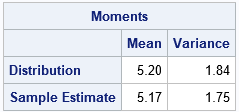
Thank you for reading CFI’s guide to Expected Value. However, NPV calculations also consider the EV of different projects. A real-life example will likely assess the Net Present Value (NPV) of the projects instead of their EV. The expected difference can be described by the sampling distribution of the mean. I know the denominator is how many ways you can choose n out N. This is the bit I can't understand, how does that probability evaluate to that value. E x i j 1 N X j P r ( x i X j) Then, P r ( x i X j) 1 / N. Calculation of the mean of a 'sample of 100' Column A Value or Score (X). I'm having a little trouble with the proof that the expected value of x i is X. Can we just use UCLXbar+3Rbar/d2 and LCLXbar-3Rbar/d2 ( 3Rbar/d2 3Sigma). Note that the example above is an oversimplified one. The table below shows the first 9 of these values, where X is an individual value or score, Xbar is the mean, and X minus Xbar is called the deviation score or delta (). This value of is different than that estimated by the average range. Therefore, your company should select Project A. The EV of Project A is greater than the EV of Project B. The EV can be calculated in the following way:ĮV (Project A) = + = $1,100,000ĮV (Project B) = + = $1,040,000 In order to select the right project, you need to calculate the expected value of each project and compare the values with each other. The distribution of the values of the sample mean (x-bar) in repeated samples. Project B shows a probability of 0.3 to be valued at $3 million and a probability of 0.7 to be valued at $200,000 upon completion. In repeated sampling, we might expect that the random samples will average. According to estimates, Project A, upon completion, shows a probability of 0.4 to achieve a value of $2 million and a probability of 0.6 to achieve a value of $500,000. Your manager just asked you to assess the viability of future development projects and select the most promising one. You are a financial analyst in a development company. Therefore, the general formula to find the EV for multiple events is:Įxample of Expected Value (Multiple Events) In such a scenario, the EV is the probability-weighted average of all possible events. However, in finance, many problems related to the expected value involve multiple events. n – the number of the repetitions of the event.

In such a case, the EV can be found using the following formula: Conditional expectation: the expectation of a random variable X, condi- tional on the value taken by another random variable Y. The first variation of the expected value formula is the EV of one event repeated several times (think about tossing a coin). It is directly related to the concept of expected return. The concept is frequently used with multivariate models and scenario analysis. By determining the probabilities of possible scenarios, one can determine the EV of the scenarios. In finance, it indicates the anticipated value of an investment in the future. It also indicates the probability-weighted average of all possible values.Įxpected value is a commonly used financial concept. Expected value (also known as EV, expectation, average, or mean value) is a long-run average value of random variables.


 0 kommentar(er)
0 kommentar(er)
